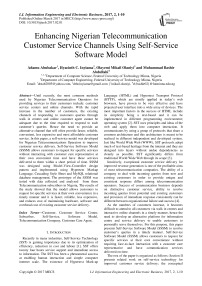Enhancing Nigerian Telecommunication Customer Service Channels Using Self-Service Software Model
Автор: Adamu Abubakar, Hyacinth C. Inyiama, Olayemi Mikail Olaniyi, Muhammad Bashir Abdullahi
Журнал: International Journal of Information Engineering and Electronic Business(IJIEEB) @ijieeb
Статья в выпуске: 2 vol.9, 2017 года.
Бесплатный доступ
Until recently, the most common methods used by Nigerian Telecommunication Operators for providing services to their customers include: customer service centers and online channels. With the rapid increase in the number of customers, the existing channels of responding to customers queries through walk in centers and online customer agent cannot be adequate due to the time required to respond to each customer's queries. Hence the need to provide an alternative channel that will often provide faster, reliable, convenient, less expensive and most affordable customer service. In this paper, a self-service model was developed for Nigerian Telecommunications Operators to improve customer service delivery. Self-Service Software Model (SSSM) allows customers to request for specific services without interacting with customer care representative at their own convenient time and have these services delivered to them within a short period of time. SSSM was designed using Model-View-Controller design pattern and implemented using Hypertext Markup Language, Cascading Style Sheet and MySQL relational database management. The prototype of the SSSM was tested with data collected and analysed from three Telecommunication subscribers in Nigeria. The results of the study showed that the model allows customers to request for specific services at their own convenience in a timely manner and it is faster, reliable, less expensive, and reduces cost of maintaining hardware, software and overhead cost of existing customer service delivery.
Customer, Customer Service Center, Subscriber, Self-Service, Software Model, Telecommunication Company, Customer Care Agent
Короткий адрес: https://sciup.org/15013498
IDR: 15013498
Текст научной статьи Enhancing Nigerian Telecommunication Customer Service Channels Using Self-Service Software Model
Published Online March 2017 in MECS
Recently in many industries, Self-Service Technology (SST) is gaining importance due to its optimization of efficiency, reduction in cost and labour [1]. SST offers twenty four hours service support and immediate access to information. The SST has been a phenomenal success at enabling human interaction and simple computer internet scale. The existence of Hypertext Mark-up
Language (HTML) and Hypertext Transport Protocol (HTTP), which are mostly applied in today’s web browsers, have proven to be very effective and have projected user interface into a wide array of devices. The most important factors in the success of HTML include its simplicity being a text-based and it can be implemented in different programming environment; operating system [2]. SST uses principles and ideas of the web and apply them into computer interaction. It communicates by using a group of protocols that share a common architecture and this architecture is meant to be realized in different independent and developed system. Just like World Wide Web (WWW), SST protocols adopt much of text-based heritage from the internet and they are designed into layers without undue dependencies as cleanly as possible. SST significantly differs from traditional World Wide Web through its scope [3].
Intuitively, exceptional customer service delivery for improved revenue generation is one of the profitable aims of most telecommunication companies. The ability of a company to deal with incoming queries from new and existing customers in order to provide unique and consistent response differs among telecommunication operators. Success of communication business depends on distinctive customer service, ability to resolve incoming queries from potential and existing customers and provision of immediate response consistently can be different between organizational failure and success [4].
As the numbers of customers increase, it becomes difficult to attend to all customers via walk in centres and interactive online channels in a timely manner, hence the need to develop an alternative platform for information centre and service delivery to enable customers to personally serve themselves. For this purpose, this paper presents Self-Service Software Model (SSSM) to resolve customer’s queries in a timely manner. Self-Service Software Model (SSSM) allows customers to request for specific services at their own convenience without requiring face-to-face interaction with a customer care representative and have communication services delivered on time.
The rest of the paper is organized as follows: Section II presents related work on self-service technology for improved customer service delivery; the conceptual framework of the developed self-service software model is presented in Section III; Section IV and Section V presented the model implementation and performance evaluation, respectively; Section VI presents the results and discussions of model evaluations; The paper is both concluded and provided scope for future research in Section VII.
-
II. Related Work
Many research works exist in the literature on selfservice technology but none discusses self-service technology for Nigerian Telecommunication Operators. SST is very significance and is of various types [5]. A service delivery platform called service storm was designed to support flexible and rapid delivery of value added services in the cloud environment in [6]. Service storm technology used web 2.0 technologies and cloud computing to design model for SSTs in telecom industries which was tested on mobile devices. Liaw and Ou in [7] implemented a wireless remote management and monitoring platform on mobile devices using Java. The security of the model and its environment were not addressed. Adoption potential can be used to measure effects of SST in apparel retail environment [8]. Customer’s behaviour towards SSTs was investigated by using adoption theory to know how it relates to customers characteristics, situation factors and innovation attributes in [9]. Relationship between need for interaction, selfefficacy and accessibility to SST were analysed statistically to developed model, which was used to assessed value that SST potentially have at university of Witwatersrand [10]. Quantitative and qualitative approaches were used to conduct empirical study and pilot test on existing SSTs in UMEA University, Sweden. The findings of the study was that certain factors such as age, friends, knowledge, money, family, use of technology in private and public places, computer tablet, mobile technology and design of SST influence the adoption of self-service technology [11]. Herbjorn and Pederson in 2011 argued that existing researches focused on variables such as age, usage, intention, attitude, satisfaction and loyalty of customers towards SSTs [12].
SST is classified based on interface (interactive voice/telephone response, internet/online) and purpose (transaction, self-help and customer service) [13]. Adoption factors for testing classification of SST based on purpose and interface was confirmed to be possible [14]. An alternate classification to Curan and Muran in [11] is non-internet and internet SSTs in [15]. View of SSTs by consumer plays important perspective and was tested using different customer view [16]. A number of advantages of SSTs were identified by consumers which include; convenience, saved time, eases of use and minimised cost. [17] argued that apart from convenience, ease of use, cost and time, consumers also enjoy the SST interaction.
With all these advantages, some consumers reject SSTs due to poor design, process failure, customer driven failure and technology failure. In spite of these failures, most customers with favourable attitude towards SSTs prefer using existing channels of SSTs due to personal relationship and interaction [18]. Other customers avoid SSTs because it requires their responsibility, risk and participation and they therefore perceived it riskier than personnel services [19]. Operators also benefit from SSTs by reducing operational cost, increasing customer loyalty and satisfaction [20] .
Furthermore, SSTs allow staff to be relieved from customer’s service delivery and routine duties, but the drawback of SSTs to service providers are related to investment involved, training of customer and staff. If the service technologies gain less adoption from customers, service providers (operators) may face increase expenses (paying the operational staff and new technology) in order to keep the services running. Company tend to minimise customers interaction, which may affect the operators negatively due to fewer chances of detecting customer complaints and service recovery. For the implementation of SSTs to be successful, high level of customer adoption must be considered so as to justify the cost of investment. In spite of the benefit and convenience of using SSTs, there are risk factors associated with it; risk variable is examined to a large extent in e-commerce buying process [21] [22]. Infusion of SSTs in telecommunication may likely be welcome by customers in spite of the benefits of the technology. Two techniques of adopting SSTs by customers were proposed, issues of confidentiality, privacy, and preferences of customers (interpersonal encounters) using the service was discussed. Further researches carried out on trust in SSTs emphasized that in electronic environment, trust is a direct antecedent of behavioural intentions [23].
-
III. Conceptual Framework of Self Service Software Model
Self-Service Software Model (SSSM) is required to perform the following transactions: SIM Replacement/SIM Swap, view call record Details, PUK request, balance enquiry, data bundle activation, activation and deactivation of call forwarding, blackberry activation, and remedy. In this section, we present the system architecture and system work flow diagram of the SSSM data model.
-
A. Architecture of Self-Service Software Model
Model-View-Controller (MVC) software architectural pattern [24] is adopted in designing the architecture of the proposed self-service software model. The MVC divides the architecture into three units such that the user interface logic is separated from business logic. The model represents the update and business functions of the system and thus changes the state of the system. The view represents the component of the user interface. It allows the user to enter commands that change the state of the system. The controller sends notice to the console using constructor, which initializes the model using defined method to gets reference to the model. Thus, the architecture of SSSM is divided into user interface layer, database layer and business logic layer as shown in Figure 1 (in the appendix). The user interface layer represents the view of the user. It consists of functional components that present what user view capture in the database to the user when a request is made. It also consists of various graphical user interfaces through which the users interact with the back-end of the system. The database layer serves as the repository for data and self-service operations. It contains all the methods that control access to the database. The business layer consists of the following components:
-
• Authorization component, which authenticates a user before been granted access to the system components.
-
• Request creator component, which negotiates with requestor to creates new request that will be added to the database.
-
• Request servicing component, which provides the backend interface through which users requests are been serviced by a backend staff.
-
• Feedback component, which executes report modules.
-
• Customer Relationship Management (CRM)
database components, which helps to update the database with required data.
-
• Knowledge browser , which allows users to search for solutions to complains.
-
B. System Workflow for Self-Service Software Model
The frontend architecture consists of the Graphical User Interface (GUI) developed using Hyper Text Markup Language (HTML) coupled with Cascading Style Sheet (CSS) and JavaScript (JS) for forms validation. An SMS gateway is configured in such a way that a user receives notification for every request he/she performed. The interface is used by the customer for sign in and access request. Web server helps to deliver the web content to the web browser. HTML specifies the style and lay out of a document (Markup Language), which is used for creating information that is displayed in web browser and pages. The CSS document in the design enables separation of layout such as fonts and color of document content from document presentation. The separation helps to improve accessibility of content, provide more control and flexibility in the specification, and in characteristics presentation. The JS allows users to interact with the client-side scripts, communicate asynchronously, control the browser and alter the document content that is displayed. JS interprets its source code and executes its script step by step. When a customer invokes a request after authentication, web server sends the request to Hypertext Processor (PHP) and access the required data from the database. The web server can then return the requested information (retrieved from the database) to the GUI as shown in Figure 2.
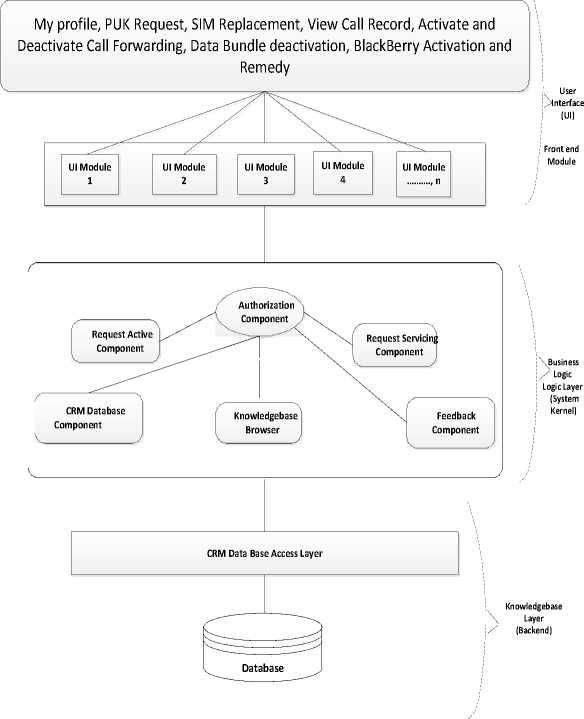
Fig.1. System Architecture of Self-Service Software Model


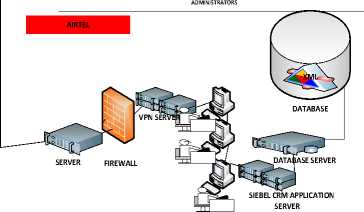
ADMINISTRATORS
Fig.2. Workflow diagram of Self-Service Software Model.
The backend consists of two servers; web server designed using Apache Tomcat and MYSQL Database server as shown in Figure 2. Apache Tomcat implements the PHP specification from micro system and provides a pure server-side HTTP environment for PHP code to run in. Apache Tomcat includes tools for management and configuration; it can be configured manually by editing its XML (configuration) files. MYSQL server communicate with the CRM application server through the database server, when user make any request, web server pages communicate to MySQL server in order to retrieve the information. If the information is not available or requires update, MySQL server communicates to Siebel CRM application server, the server in turn retrieved the data from the operator’s database. An internet modem connected to the computer via Universal Serial Bus (USB) port provides interconnectivity to the system. Simple Object access Protocol (SOAP) sends and receives all messages using XML format, it also uses HTTP and XML as method for mechanism. SOAP does this by defining an extensible simple message format (in standard XML) and provides a means to send the XML message over HTTP.
-
C. Self-Service Software Data Model
Self-service database component is represented using concept of relational data model. Supposing an n sets of D1 , D2 , D3 , D4 , , Dn with relation R is a set of n -tuples:
Furthermore, If set of relation schema are P1, P2, P3, P4,...., Pn, then the relational database schema is represented as:
P = { P1, P2, P3, P4,.....,Pn }
Where: P1, P2, P3, P3,.....,Pn are distinct set of tuples schemas with unique attributes over a given domains.
The database of self-service is a network of objects, which are related semantically. Thus the relational database schema of the self-service_software_model is:
self_service_software_model = {blackberry_activation, call_forwarding, call records,, data_bundle, puk_request, remedy, sim_replacement, users} and their relation schemas are:
-
a. blackberry_activation[id: varchar, plan: varchar,
status: varchar ]
-
b. call_forwarding[id: varchra ,Forward_number: va
rchar , status: varchar ]
-
c. call-
- records[id:varchar,call_date_time:datetime,call_ duration:double, dialled_number:varcha,
total_amount: double , amount_before: double, amount_after: double, call_type: varchar, data_volume: double ]
-
d. data_bundle[date_posted: datetime, id: varchar, plan: varchar, status: varchar ]
-
e. puk_request[id: varchar, request_type: varchar, status: varchar ]
-
f. remedy[date_posted: datetime, id: varchar ,
subject: longtext, status: varchar]
-
g. Sim_replacement[id: varchar, puk: varchar,
sn: varchar, status: varchar ]
-
h. Users[user_id: varchar, password: varchar,
surname:varchar, other_names:varchar, network:varchar, user_title:varchar, date_of_birth:date, sex:varchar, state_of_origin: varchar, lga:varchar, nationality:varchar, occupation:varchar, alternate_number:varchar, residence_address:varchar, contact_address:varchar, email:varchar, status:varchar, puk:varchar, year_of_activation:int, tarrif plan:varchar].
The data-object logical relationship software model is shown in figure 3 (in the appendix).
-
D. Transactions on Self-Service Software Model
The following transactions can be performed on Self Service Model:
-
a. View Call Record Details
A call record detail (also known as call data record) is a record detail of calls produced by telecommunications exchange / equipment containing attributes for specific user’s phone call or other transactions performed by user with the device or facility. This detail may include the phone number of both the caller and the receiver, the start time, the duration of making call or receiving call, the date etc. In a modern telecommunication company, a call record is expected to exhibit the following attributes:
-
i. The telephone number of calling party (subscriber originating the call).
-
ii. The phone number of the called party (subscriber receiving the call).
-
iii. The time of call (the starting time) and the date.
-
iv. The call duration.
-
v. The amount charged for the call (i.e. the required billing).
-
vi. The identification of the equipment or telephone exchange writing the call.
-
vii. A unique number (i.e. unique sequence number) identifying the record.
-
viii. An indicator indicating whether the call was connected or not.
-
ix. Route used by the call to enter the exchange.
-
x. Route used by the call to leave the exchange.
-
xi. Type of call (SMS, voice, data, etc.)
-
xii. Fault encounter
User can click on the call record detail button to view specific records from the SSSM.
-
b. Activation and Deactivation of Call Forwarding
Call forwarding (also known as call diversion) is a feature in telephone switching system which redirects a phone call to another destination such as voice box or to another number. Whenever call forwarding is activated on a line, the line usually rings once to remind the owner that the incoming call is being redirected to another number. At times call forwarding is being indicated by stutter dial tone. Call forwarding is activated if the line is busy, out of reach, or not answered etc. Call forwarding can be activated and deactivated.
-
c. BlackBerry Data Activation
BlackBerry is a wireless hand held device designed and marketed by Blackberry Limited (Formally known as Research in Motion (RIM) Limited). The blackberry activation in our SSSM enables blackberry users to activate blackberry plan on their devices. This plan can be daily, weekly, monthly, quarterly and annually. With active blackberry subscription, users can send email, fax, surfing the net, receive emails and perform other wireless service.
-
d. SIM Replacement/ SIM Swap
A Subscriber Identity Module/Subscriber Identification Module (SIM) swap simply means exchanging one SIM serial with another. This exchange is performed when a customer SIM is stolen with phone, broken, damaged etc. SIM swap is performed by replacing the serial number (while at the same retaining the mobile subscriber integrated digital number also known as Mobile Station International Subscriber Directory Number (MSISDN) with another serial number. The subscriber can performed SIM swap by entering the new serial number and the Personal Unblocking Key (PUK) of the welcome back pack obtained from the operator and then click on the SIM swap button.
-
e. Personal Unblocking Key (PUK) Request
Personal Unblocking Key (PUK) is specific codes assigned by telecommunication service provider, which can be used to reset Personal Identification Number (PIN) in case of theft, forgotten or lost. PUK is impossible to guess and once entered will be required to reset the Personal Identification Number (PIN). Most telecommunication company offer the PUK for protection, when a phone is switch on, if the security function PIN is active, the subscriber will be required to enter the 4-digit PIN to unblock the SIM. If the user enters wrong PIN more than three times, the SIM remain blocked and user will be required to enter the PUK. When user enters correct 8-digit PUK, user will also be required to enter the new PIN (of his choice) twice before the SIM can be unblocked. If the user entered wrong PUK several times, the SIM becomes permanently block and user must perform a SIM swap in order to get the SIM change.
SubcriberRegistration
-User_ID
-Surname
-Firstname
-DateofBirth
-ContactAddress
-HomeAddress
-EmailAddress
-Username
-Password
-Photo : object
+subscriberRegistration( ):() : string
Subscriber Valiation
-User_id
-password +login() +Validate()
0..1
-Add to profile
-Authenticate
SIM Replacement
-user_id
-puk
-sn
-status
+SubmitRequest()
-Request for
-
1..1
0..1
Subscriber
-get puk
0..1
-user_id
-pin
-status
PUK Request
+Request_PUK() :
1..*
Profile Update
-surname
-other_names
-middle_name
-user_title
-date_of_birth
-user_id
0.._1
-password
-surname
-other_names -middle_name -network -user_title -date_of_birth
Call Forwarding
-Request
0..1
-user_id
-forward_number
-status
+ActivateCallForwarding() : int
+DeactivateCallForwarding() : int
-sex
-state_of_origin
-lga
-nationality
-occupation
-residential_address
-contact_address
-employer
-year_of_activation : int
-tarrif_plan
+update_profile()
-Add to
0..1
Call Data Records
-user_id
-call_date_time
-call_duration : double
-dialed_number
-total_amount : double
-call_type
-amount_before : double
-amount_after : double
-data_volume : double
+ViewCallRecords()
-Request
0..1
-sex
-state_of_origin
-lga
-nationality
-occupation
-alternate_number
-residence_address
-contact_address
-status
-puk
-employer
-year_of_activation : int
-tarrrif_plan
-photo
-security_PIN : char
+select_from*() : string
0..1
1..*
-Redirect call
0..1
Backend
-complain
-user_id
-password
+AddRemRequest()
0..1 -send complain
01..1
Remedy
-Activate 0..1
-Subscribe
-user_id
-date_posted
-subject
-complain
-status
+SubmitTicket()
Blackberry Activation
-user_id
-plan
-status
-date_and_time
+ActivateBlackBerry()
Data Bundle Subscription
-user_id
-request_type
-pin
-status
+ActivateBundle() : double
Fig.3. Data Object Logical Relationship Software Model
-
f. Account Balance Enquiry
Account balance simply means the available airtime in user’s account. Users can check this balance by either using Unstructured Supplementary Service Data (USSD) codes on their phone or by clicking on account balance enquiry on SSSM.
-
g. Activate Data Bundle Activation
This simply means the bundle packages used for surfing and downloading from internet using devices such as phones, tablets, laptops, desktops etc.
-
IV. Model Implementation
This section discusses the implementation of SelfService Software Model, features and composition of both the front-end and the back-end. The following tools were used for the implementation: a) MySQL for designing the database management system. b) Apache Tomcat for designing the web server c) PHP for the total programming of the model and d) Hypertext Markup Language and Cascading Style sheets for the front end Graphical User Interfaces. The Software model runs on Windows Operating System. The minimum hardware specification required to implement the SSSM is Pentium IV with 2.5 MHz processor, 120GB hard disc and 1GB RAM. Apache Tomcat implements the PHP, specification from micro system and provides a pure server-side HTTP environment for PHP code to run in. Apache Tomcat includes tools for management and configuration; it can be configured manually by editing its XML (configuration) files. MySQL server communicates with the Customer Relationship Management (CRM) application server through the database server, when user make any request, web server pages communicate to MySQL server to retrieve the information. If the information is not available or it requires update, MySQL server communicates to Siebel
CRM application server, the server in turn retrieves the data from the operator’s data base. An internet modem connected to the computer via Universal Serial Bus (USB) port provides interconnectivity to the system.To use the model, a user is required to enter his/her username and password then click the login button. When a customer invokes a request after authentication, web server sends the request to PHP and access the required data from the database. The web server can then return the requested information (retrieved from the data base) to the Graphical User Interface (GUI). Communication between the front-end and back-end is possible with the help of Simple Object Access Protocol (SOAP). SOAP sends and receives all messages using XML format, it also uses HTTP and XML as method for mechanism. Both Siebel and SSSM platform communicate to Siebel application server and the database using XML message format/document. SOAP does this by defining an extensible simple message format (in standard XML) and provides a means to send the XML message over HTTP. After successful login, the welcome screen display user’s full name and image (Figure 4). User selects the transaction he/she wishes to perform from the SSSM menu (figure 5), To perform transaction on SSSM, User needs to select a task from the SSSM menu as shown in Figure 5. For instance, if a user wants to perform SIM swap. User enters his/her existing PUK (old PUK), enters the serial number (SN) and PUK of the purchased PrePaid Welcome Back (PPWB kit into the “New SN” and “New PUK” fields, respectively as shown in Figure 6.
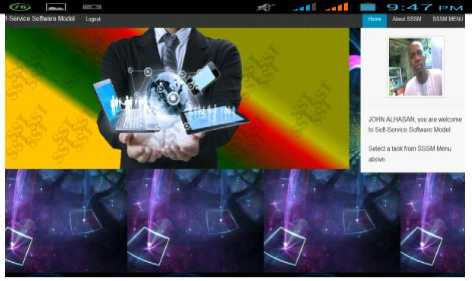
Fig.4. SSSM Welcome Screen
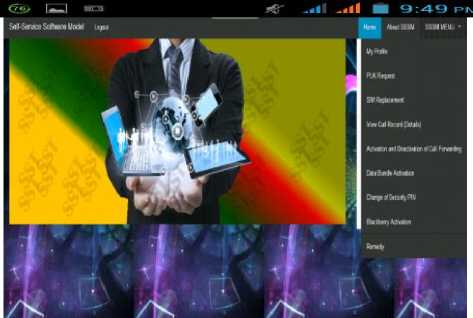
Fig.5. Transactions on SSSM
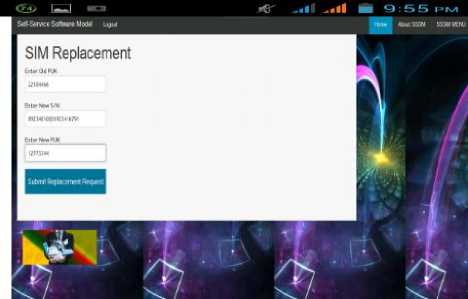
Fig.6. SIM Replacement on SSSM
-
V. Model Performace Evaluation
The performance of the developed self-service software model and existing customer service channels was evaluated for usability, accessibility, confidentiality, subscriber’s authentication for efficient customer service delivery through the perception assessments of these qualities by subscribers through administration of questionnaires after using the existing customer service channels and the developed self-service software system based on SSSM in Figure 1, 2 and 3. The study area comprises of registered MTN, GLO and Airtel Nigeria Telecommunication Limited subscribers of acceptable age range within Minna, Niger State, Nigeria. Data were collected in form of questionnaire after respondents used the existing customer service channels and the developed software system. The usability, accessibility, confidentiality, and subscriber authentication of the existing customer service channels and the developed self-service software model were evaluated on mobile and other electronic platform qualitatively using the five point Likert scale after administration of questionnaire for selected numbers of questionnaires as does in [25] A well-structured questionnaire was used to assess usability, confidentiality, verifiability and validation factors. Cronbach’s alpha test in statistical package for social science (SPSS) was used in testing and validating the questionnaire for reliability. The respondents were registered MTN, GLO and Airtel Nigeria Telecommunication Limited subscribers. A total of sixty (60) questionnaires were distributed for the assessments of existing customer service channels and the developed self-service software model system for usability, confidentiality and authentication to influence the assertion that software model have the capacity to deliver efficient customer service than the existing customer service channels. Fifty six (56) responses were received from duly filled user’s forms (questionnaires) and the primary data from the questionnaires were captured, compiled and analysed using SPSS version 11.5 for Windows environment using descriptive data analysis, of the fifty six (56) respondents, twenty are females and thirty six (36) are males. The four performance evaluation metrics based on earlier requirements (usability, accessibility, confidentiality, and subscriber authentication) formulated were measured and the findings are presented in the next section.
-
VI. Results and Discussion
Considering each of the service requirements in the responses, findings from assessments of usability requirement of the developed self-service software model revealed that over eighty two percent (82.2%) of respondents (from questionnaire) cumulatively agreed that the developed self-service software model could deliver efficient customer service as showed in usability row of Table 1. This is similar to the findings from assessments of usability requirement of the existing customer service channels reveal that over eighty two percent (82.2%) respondents cumulatively agreed on the existing customer service channels in usability row of Table 2.
The authentication assessment of the model by subscribers revealed that the developed self-service software model could allow subscriber to verify and validate their account before been granted access to the software system with respondents’ cumulative agreement of 87.5 % shown in the authentication of subscriber row in Table 1.
The findings of subscriber’s privacy and confidentiality assessments to users account in the developed model revealed that over eighty seven percent (87.5%) cumulatively agreed that the developed selfservice software model preserve their privacy and confidentiality as shown in the appropriate row of Table 1. Similarly, the findings of subscriber’s privacy and confidentiality assessments to users account in the existing customer service channels revealed that over ninety one percent (91.1%) cumulatively disagreed that the existing customer service channels could preserve their privacy and confidentiality as shown in confidentiality and privacy row of Table 1.
Table 1. Users Perception on Developed SSSM
|
Parame ters /Percept ion |
Strongly Disagree % |
Disagr ee % |
Neutral % |
Agre e % |
Strongly Agree % |
Cumula tive Agreem ent |
|
Usabilit y |
1.8 |
10.7 |
5.4 |
55.4 |
26.8 |
82.2 |
|
Subscrib er Authenti cation |
3.6 |
1.8 |
7.1 |
41.1 |
46.4 |
87.5 |
|
Subscrib er Privacy |
1.8 |
5.4 |
3.6 |
46.4 |
41.1 |
87.5 |
|
Accessib ility of the SSSM |
0 |
0 |
3.6 |
60.7 |
35.7 |
96.4 |
The findings of accessibility assessments revealed that over ninety six percent (96.4%) cumulatively agreed that the developed self-service software model is accessible in respective of their location as shown in accessibility row of Table 1. Furthermore, the findings of accessibility assessments of the existing customer service channels revealed that over eighty seven percent (87.5%) cumulatively disagreed that the existing channel is accessible irrespective of their location as shown in accessibility row of Table 2.
The result of performance evaluation metrics of user’s perceptive responses of the developed SSSM indicated that 46 out of 56 subscribers rated the system usability above average with a response mean System Usability Index (SUI) value of 3.94. The subscriber authentication was rated above average with System Degree of Subscriber Verification and Validation (SDS2V) value of 4.25 by 49 out of 56 subscribers. The subscriber’s information privacy and confidentiality of the system was rated above average with System Confidentiality Index (SCI) value of 4.25 by 49 out of 56 subscribers. The accessibility of the self-service software system was also rated above average with System Accessibility Index (SAI) value of 4.32 by 54 out of 56 subscribers.
Table 2.Users Perception on Existing Customer Service Channels
|
Paramet ers /Percepti on |
Strongly Disagre e % |
Disagr ee % |
Neutr al % |
Agre e % |
Strongly Agree % |
Cumula tive Agree ment |
|
Usability |
8.9 |
7.1 |
1.8 |
80.4 |
1.8 |
8.9 |
|
Subscribe r Authentic ation |
17.9 |
30.4 |
28.6 |
14.3 |
8.9 |
23.2 |
|
Subscribe r Privacy |
75 |
16.1 |
1.8 |
5.4 |
1.8 |
7.2 |
|
Accessibi lity of the SSSM |
33.9 |
53.6 |
7.1 |
5.4 |
0 |
5.4 |
However, the result of performance evaluation metrics of user’s perceptive responses of user’s responses for the existing customer channels indicated that 46 out of 56 subscribers cumulatively rated the existing customer service channels usability above average with a response mean System Usability Index (SUI) value of 3.6. Also, the subscriber authentication was rated below average with System Degree of Subscriber Verification and Validation (SDS2V) value of 2.6. The subscriber’s information privacy and confidentiality of the existing customer service channels was rated below average with System Confidentiality Index (SCI) value of 1.4. The accessibility of the existing customer service channel was also rated below average with System Accessibility Index (SAI) value of 1.8. Table 3 shows summary of performance evaluation of customer service delivery of the developed self-service software and the existing customer service channels. The results of the developed SSSM shows better customer satisfaction and acceptance compare to existing telecommunication customer service channels.
Table 3. Results of performance evaluation on Developed SSSM
|
Performance Metrics |
Respo nse Design Target |
Number of Response |
Response Mean of SSSM |
Response Mean of ECSC |
|
System Usability Index (SUI) |
>3 |
56 |
3.94 |
3.6 |
|
System Degree of Subscriber Verification and Validation (SDS2V) |
>4 |
56 |
4.25 |
2.6 |
|
System Confidentiality Index (SCI) |
>4 |
56 |
4.25 |
1.4 |
|
Accessibility Index (SAI) |
>4 |
56 |
4.32 |
1.8 |
-
VII. Conclusion and Recommendations for Future Research
This paper presented an enhanced customer service channel for improved revenue generation through the development of software prototype of Self-Service Model for Nigeria telecommunication companies. This was achieved by studying and analysing the existing customer service channels in MTN Nigeria, Globacom Nigeria and Airtel Nigeria limited. The developed self-service software model enables GSM subscribers of these telecommunication operators to request for a specific service without interacting with the customer care representative. Self-service paradigm enables companies to reduce cost of customer interaction; collect more information and identify new customers. This in turn increase revenue and improve customer retention. Selfservice technologies are used as substitute to face to face interaction for the purpose of making companies transactions faster, convenient and more accurate. Selfservice software model was developed, tested and evaluated to measure the adoption and effectiveness in customer’s environment. The developed model was found to be faster, less expensive, convenient, and more accurate. Our recommendation for future researcher is premised along the application of steganography, cryptography and watermarking to enhance the security of the model.
Список литературы Enhancing Nigerian Telecommunication Customer Service Channels Using Self-Service Software Model
- Anitsal, J. (2005). Technology Based Self-Service from Customer Productivity toward Customer Value. Doctoral Dissertation, University of Tennessee, Knoxville. pp 1-51
- Avinash, T., Tejas, G., Suclarshan, K., and Akash R. (2013). Intranet Based Academic Web Server. International Journal of Emerging Technology and Advanced Engineering, 3(4), 1-25.
- Lie, H. W., and Bos, B. (1997). Cascading style sheets. Boston: Addison-Wesley.
- Beatson, A., Coote, L. V., and Rudd, J. M (2006). Determining Consumer Satisfaction and Commitment through Self-Service Technology and Personal Service Usage. Journal of Marketing Management, 22(7), 853-882.
- Micheal, L. K. (2008). Convergence of Self-Service Technology. Michigan: Spring. pp 122-128.
- Yu, C. Z., Liang, X. X., Xi Ning, W., Xiao, X. X., and Chang, H. S. (2010). Service Storm: A Self-Service Telecommunication Service Delivery Platform with Platform as a Service Technology. Beijin SOA Centre..Chow, S. (2009). Setting up gammu with smsd. Retrieved from http://saysstory. blogspot.com/2009/03/setting-up-gammu-with-smsd.html. [Accessed November 06, 2013]
- Liebermann, Y., and Stashevsky, S. (2002). Perceived Risk as Barriers to Internet and E-Commerce Usage. An International Journal on Quantitative Market Research, 5(4), 291-301.
- Sooeun, C. (2011). Self-Service Technology: An Investigation of the Potential for the Adoption in Apparel Retail settings. Unpublished Desertation. University of Carolina, Greens Boro.
- Jinhui, W. and Jose, N. (2004). Customer Adoption of Technology-Based Self-Service: A Case Study on Air Airport Self Check in Service. Unpublished M. Sc, Lulea University of Technology, Sweden.
- Yandisa, N., and Norman, C. (2014). An Assesment of the Effectiveness of Self-Service Technology in University Environment: A Case Study of University of Witwatersrand. Mediterranean Journal for Social Sciences, 5(14), 413-419.
- Muhammad, S.B., and Sameh, A. H. (2011). Factors Influencing the Adoption of Self-Service Technology: Study of Attitudes towards Self-Service Technologies. Master Thesis. UMEA, Sweden. pp 1-12.
- Herbjorn, N., and Pederson, P. E. (2011). Self-Service Technology: An overview of Existing Research Working Paper. Norway: CSI, Bergen, 5(11), 1-18.
- Meuter, M., Ostrom, A., Roundtree, R., and Bitner, M. (2000). Self Service Technologies: Understanding Customer Satisfaction with Technology based Service Encounters. Journal of Marketing, 64(7), 51-58.
- Curran, J., and Meuter, M. (2005). Self-Service Technology adoption, Comparing Three technologies. Journal of Service Marketing, 19(2), 102-112.
- Forbes, L. (2008). Non Internet Technology Failure and Recovery. Journal of Service Marketing, 22(4), 316-325.
- Cunningham, L., young, C. and Gerlach, J. (2008). Consumer View of Self-Service Technology, Service Industries Journal, 28(6), 719-723.
- Dabholkar, P., Bobbit, L. and Lee, E. (2003). Understanding Consumer Motivation and Behaviour Related to self-Scanning in Retailing. International Journal of Service Industries Management, 14(1), 59-95
- Dabholkar, P., and Bagozzi, R. (2002). An additional Model of Technology-Based Self-Service Moderating Effect of Consumer Traits and Situational Factors. Journal of Marketing Science, 30(3), 184-201.
- Lee, J., and Allaway, A. (2002). Effect of Personal Control on Adoption of Self-Service Technology Innovation. Journal of Service Marketing, 16(6), 552-574.
- Bitner, M., Ostrom, A., and Meuter, M. (2002). Implementing Succesful Self-Service technologies, Journal of Academy of Management Execution, 16(4), 96-104.
- Forsythe, S., and Shi, B. (2003). Consumer Patronage and Risk Perceptions in Internet Shopping. Journal of Business Research, 56(11), 86-875.
- Cunning, L., Gerlach, J., Harper, M. and Young, C. (2005). Perceived Risk and Consumer Buying Process: Internet Airline Reservations, International Journal of service management, 16(4), 356-374.
- Yousafzai, S., Pallister, J., and Foxhall, G. (2009). Multi-Dimensional Role of Trust in Internet Banking Adoption. A Journal on Service Industries, 29(5-6), 590-606.
- Wiggers, C., and Galbraith, B. (2004). Professional Apache Tomcat. San Francisco: John Wiley & Sons.
- Olaniyi, M. O., Arulogun, O. T., Omidiora, E. O., and Okediran, O. O (2014). Performance Assessment of an Imperceptible and Robust Securred E-Voting Model. International Journal of Scientific and Technology Research, 3(6), 1-6.

